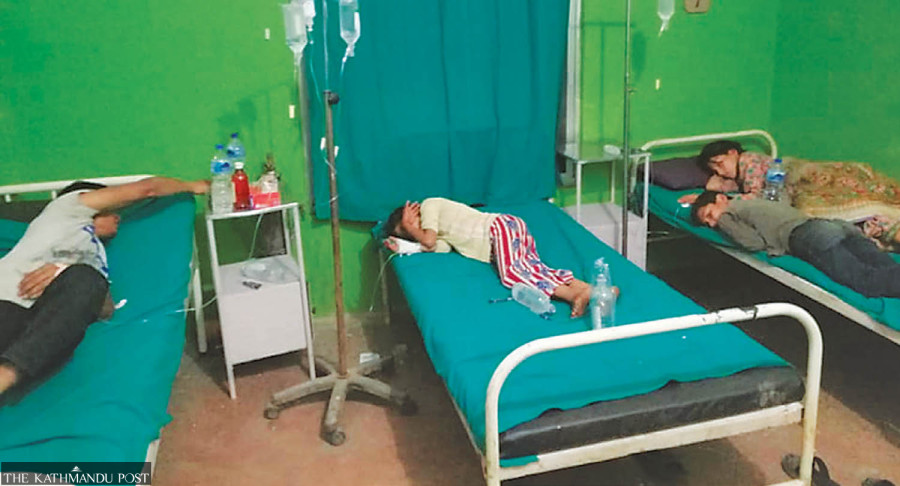Health
Climate crisis linked to diarrhoea cases’ rise
New report presents evidence linking weather factors and the disease’s burden in Nepal.
Arjun Poudel
Over the past few years, scientists have gathered credible evidence linking the climate crisis to adverse health effects that impact the quality of life and kill people.
A new report says there could be an increase in diarrhoeal disease incidence across Nepal, especially in the mountainous region that is more sensitive to climatic variability.
“Overall diarrhoeal disease incidence in Nepal significantly increased with 1 degree Celsius increase in mean temperatures and 1 cm increase in rainfall,” reads the report of the national-level ecological study.
Diarrhoeal disease is a common and seasonal public health issue usually triggered by food and water safety or hygiene issues. The disease has been associated with higher temperatures and is one of Nepal’s leading causes of morbidity and mortality.
“The national-level ecological study was undertaken to provide evidence linking weather and climate with the diarrhoea incidence in Nepal,” said Megnath Dhimal, the report's principal investigator. “Our study shows regional differences due to differences in socioeconomic status, development level, population density, and access to water sanitation and hygiene.”
In October 2021, Kapilvastu district witnessed a massive cholera outbreak, which killed at least four, including three minors, and infected over 1,200 people.
Stool samples of patients confirmed the presence of Vibrio Cholera 01 Ogawa serotype and E coli bacteria in drinking water samples of the disease-hit areas.
According to officials at the Ministry of Health and Population, diarrhoeal diseases could be several times more than the reported cases as most cases are unreported to health facilities and there’s no system to track outbreaks.
“Due to easy contamination of food and water sources and favourable temperatures for the spread of bacteria causing diarrhoea, diarrhoeal diseases are common during the monsoon season,” Dhimal added.
Ministry data from the last fiscal year show that for every 1,000 children under five years of age, 349 suffered from diarrhoeal diseases.
According to the World Health Organisation, diarrhoea is the second leading cause of mortality in children under five. The disease has also been linked with growth and cognitive shortfalls in children, especially in marginalised communities.
Nepal is one of the most vulnerable countries to the climate crisis and has witnessed extreme weather events in the past decade and a half.
Evidence indicates that the maximum temperature in Nepal is rising at a greater rate (0.05 degrees Celsius per year) than the minimum temperature (0.03 degrees Celsius per year).
While floods and landslides triggered by extreme rainfall and instances of massive forest fires and prolonged droughts receive considerable attention for the casualties and the trail of destruction they leave behind, the adverse effects on health have received little attention.
And in the case of diarrhoea which is temperature-sensitive, new evidence suggests that extreme climatic and seasonal variables in the form of temperature and precipitation significantly increased overall diarrhoeal disease incidence in Nepal.
A 1 degree Celsius increase in mean temperature was associated with a 4.4 percent increase while a 1 cm increase in rainfall led to a 0.28 percent increase in cases, according to the study which analysed monthly diarrhoeal disease count and meteorological data from all districts for the period from 2002 to 2014.
“Our study provides empirical evidence linking weather factors and diarrhoeal disease burden in Nepal, '' said Dinesh Bhandari, co-investigator of the study. “This evidence suggests that additional climate change could increase diarrhoeal disease incidence across the country.”
The authors of the new study also estimate that the climate crisis will have a considerable impact on the burden of diarrhoeal disease, which is a leading cause of childhood morbidity and mortality in Nepal.
The recent damning report by the Intergovernmental Panel on Climate Change also warned that South Asian countries are particularly vulnerable to the climate crisis.
The overall health impacts as a direct consequence of the climate crisis, experts say, need considerable attention as Nepal is already witnessing shifting patterns of disease vectors alongside ecological disruptions.
The effects of the climate crisis combined with the prevalence of open defecation and lack of access to safe drinking water also concern public health officials who stress allocating necessary resources and envisioning an early warning system to prevent and control diarrhoeal diseases.
“We cannot prevent the climatic change, but we can take measures that save us from the direct impact of the climatic crisis,’ said Dr Sher Bahadur Pun, chief of the clinical research unit at Sukraraj Tropical and Infectious Disease Hospital. “If we can eat fresh foods, drink safe drinking water and pay attention to personal hygiene, we can lessen problems of water-borne diseases to some extent. Authorities concerned should also pay heed to the emerging threats.”




 7.12°C Kathmandu
7.12°C Kathmandu














